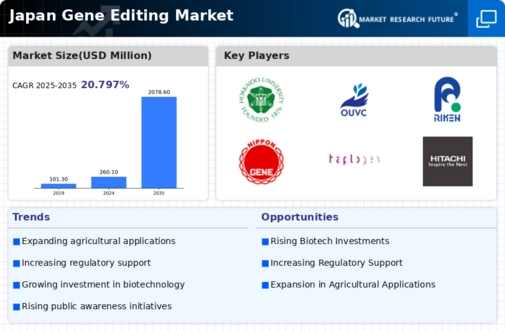Government Initiatives and Funding
Government initiatives in Japan are significantly impacting the gene editing market. The Japanese government has been actively promoting biotechnology research through funding programs and grants aimed at fostering innovation. In 2025, the government allocated approximately $300 million to support gene editing research and development projects. This financial backing is crucial for startups and established companies alike, as it enables them to explore new applications and technologies in the gene editing market. Furthermore, the establishment of regulatory frameworks that encourage safe and ethical research practices is likely to enhance public trust and acceptance of gene editing technologies. As a result, these government initiatives are expected to stimulate growth and investment in the gene editing market.
Growing Public Awareness and Acceptance
Public awareness and acceptance of gene editing technologies are gradually increasing in Japan, which is positively influencing the gene editing market. Educational campaigns and outreach programs are helping to demystify gene editing, highlighting its potential benefits in medicine and agriculture. Surveys indicate that approximately 60% of the population is now supportive of gene editing applications, particularly in healthcare. This growing acceptance is likely to encourage investment and research in the gene editing market, as stakeholders recognize the importance of public perception in the successful implementation of these technologies. Moreover, as more success stories emerge, the confidence in gene editing solutions is expected to strengthen, further propelling the market forward.
Rising Demand for Personalized Medicine
The gene editing market is witnessing a notable increase in demand for personalized medicine in Japan. As healthcare shifts towards tailored treatments, gene editing technologies are becoming essential for developing therapies that cater to individual genetic profiles. This trend is particularly evident in oncology, where targeted therapies are being designed based on genetic mutations. The market for personalized medicine is anticipated to reach $5 billion by 2027, with gene editing playing a pivotal role in this transformation. Additionally, the growing awareness among patients and healthcare providers about the benefits of personalized treatments is likely to further propel the gene editing market. This shift towards individualized healthcare solutions underscores the importance of gene editing technologies in addressing complex medical challenges.
Technological Advancements in Gene Editing
The gene editing market in Japan is experiencing a surge due to rapid technological advancements. Innovations such as CRISPR-Cas9 and TALEN are revolutionizing the field, enabling precise modifications in genetic material. These technologies are not only enhancing research capabilities but also facilitating the development of novel therapies for genetic disorders. The market is projected to grow at a CAGR of approximately 15% from 2025 to 2030, driven by these advancements. Furthermore, the integration of artificial intelligence in gene editing processes is expected to streamline workflows and improve accuracy, thereby attracting more investments into the gene editing market. As a result, Japan is positioning itself as a leader in the gene editing market, fostering an environment conducive to innovation and growth.
Increased Focus on Agricultural Biotechnology
The gene editing market in Japan is also being driven by an increased focus on agricultural biotechnology. With the need for sustainable food production rising, gene editing technologies are being utilized to develop crops that are more resilient to climate change and pests. The market for agricultural biotechnology is projected to grow by 10% annually, with gene editing playing a crucial role in enhancing crop yields and nutritional value. Japanese companies are investing in research to create genetically modified organisms that can thrive in adverse conditions, thereby addressing food security challenges. This emphasis on agricultural applications of gene editing not only supports the agricultural sector but also contributes to the overall growth of the gene editing market.

















Leave a Comment